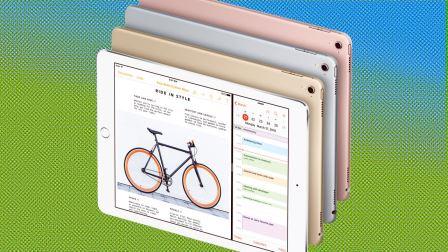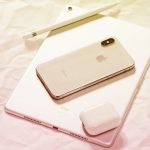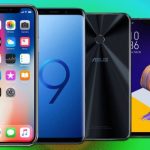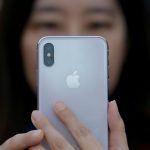9.7″ iPad Pro Review: It’s Two Tablets In One
For months, the Apple rumor mill predicted that the company was going to unveil the iPad Air 3, a 9.7″ tablet with a variety of hardware improvements and support for the Pencil stylus and Smart Keyboard.
And then the scuttlebutt took a new turn. The new theory was that the company’s new tablet would be a smaller version of its iPad Pro. It would be . . . a 9.7″ tablet with a variety of hardware improvements and supports for the Pencil stylus and Smart Keyboard. That, indeed, was the device that the company unveiled at its media event in March.
On one level, it may seem silly to obsess over the distinction between the two iPads that were rumor fodder in the run-up to the launch. They differed only in model name. Big whoop!
But when you think about it, the fact that a device with a single set of specs and capabilities could be interpreted as either a successor to the iPad Air 2 or a smaller version of the 12.9″ iPad Pro is actually a telling point. To appeal to as many prospective buyers as possible, the new iPad has to appeal to two constituencies: people who might be induced to upgrade from previous 9.7″ iPads, and power users of the sort that the 12.9″ model already addresses.
And so it makes sense for a reviewer like me to write not one review, but two.
Review #1: The 9.7″ iPad Pro as an upgrade to earlier iPads
For eight quarters now, sales of the iPad—which once seemed to be an iPhone-like phenom—have dropped. When analysts have asked Apple CEO Tim Cook about the plunge during financial calls, he’s explained it by saying that consumers like the iPads they own just fine—so much, in fact, that they don’t see a burning need to buy a new iPad.
If you were going to build an iPad expressly designed to convince such folks to upgrade, you’d want to revise the hardware in ways that went beyond the hardly noticeable improvements that are often the norm when version 2 of something gives way to version 3. Ideally, you wouldn’t just give it a faster processor and a sharper screen and a few more megapixels of camera resolution; you’d also add some capabilities that are all-new.
That’s the 9.7″ iPad Pro in a nutshell. Apple was so serious about making it more capable than its 9.7″ ancestors that it skipped its usual effort to shave off weight and thickness. In nearly every respect, the design philosophy at work involves packing as much power and versatility as possible into a device that, at first glance, you might mistake for an iPad Air 2.
Some of the 9.7″ iPad Pro’s enhancements are ones of the sort that Apple makes pretty much every time it updates a device. The new tablet sports an A9X processor that, Apple says, is up to 1.8 times faster than the A8X inside the iPad Air 2. As usual, that’s less about correcting a deficiency with the previous model—the Air 2 sure doesn’t feel like a laggard—than it is about giving the most demanding apps, such as games and video editors, as much computational oomph as possible. By raising the computing-muscle bar with each new generation of iPad, Apple also encourages all categories of apps to grow more sophisticated over time.
Apple implemented several improvements to the tablet’s display; none of them are individually transcendent, but they add up to the best screen an iPad has ever had, by a big enough margin to care about. The 25% increase in brightness over the iPad Air 2 is very noticeable—when I tested it by cranking it up to 100% in a room with typical lighting, it was like aiming a spotlight into my eyes—and a boon if you use the tablet outdoors, where sunlight can bleach out dimmer screens. The color gamut is also wider, making for more saturated photographs.
Then there’s True Tone, an all-new technology that uses light sensors embedded in the tablet’s bezel to measure ambient lighting and adjusts the display to maintain consistent colors in a variety of environments. It’s especially apparent in apps with a lot of white space, such as e-book readers and word processors. They look more soothingly paper-like and less like they’re made up of glowing pixels trying to approximate the look of ink on dead trees.
As part of Apple’s “let’s give people every possible reason to buy this iPad” strategy, it’s not only bumped up the quality of the tablet’s cameras, but brought them all the way to parity with the iPhone 6s. The new iPad Pro has the same sensors as the 6s, front and back, and the same bump on the back. It’s also the first iPad with multiple picture-improving technologies that first appeared on iPhones, such as the True Tone dual-LED flash, 4K video capture, Live Photos mini-videos, autofocus with focus pixels, and ability to produce a burst of light from the display to serve as a flash for front-camera selfies. That’s a big shift from earlier iPad cameras, which have never aspired to be anything other than adequate.
Here’s a comparison of the new iPad Pro camera (left) and the iPhone 6s Plus camera—the latter has optical stabilization, which the iPad lacks, but for typical photos taken in daylight, the quality seemed indistinguishable to me.

And here’s the 9.7″ iPad Pro (left) handling a difficult nighttime photo way better than the murky, blurry results from the 12.9″ model’s camera.

Now, the churls who have long mocked those who take photos with iPads might argue that the new iPad Pro has better cameras than it actually deserves. I’m already on the record as believing that it’s silly to be annoyed when other people use their tablets as cameras. But the biggest argument for giving an iPad an excellent camera isn’t so you can use it in situations where a smartphone would be more practical. It’s because there are also tablet-friendly applications that benefit from the ability to snap a high-quality photo.
For instance, I like to sell items on eBay using the auction site’s iPad app. With the new iPad Pro, I could take excellent pictures of my goods without futzing with a second device.
The new iPad Pro’s audio system—another aspect of the tablet that Apple has tended to neglect until recently—features the same four-speaker design as the larger iPad Pro. Higher frequencies always get pumped out of the uppermost speakers, whether you’re holding the tablet in landscape or portrait orientation, and you can crank up the volume for music, movies, and games without the sound devolving altogether into a tinny, distorted mess. For a tablet, that’s impressive.
So much for the iPad Pro improvements, which are about improving the experience by upping the tablet’s basic specs. With the Pencil and Smart Keyboard—two accessories that are extra-cost options, but tremendously significant ones—Apple aims to encourage people to use this iPad as a tool for creativity and productivity.
The highest compliment you can pay Apple’s $99 pressure-sensitive Pencil stylus is that it instantly renders every third-party iPad stylus obsolete, with the possible exception of the sort that are so cheap that you can treat them as carelessly as if they were meant to be disposable. It’s a pleasure to hold and wonderfully precise, and just about all of the apps that should support it—ones for painting, drawing, and note-taking—already do. If you’re an artistic type and own an earlier iPad, the upgrade to the 9.7″ iPad Pro is going to be severely tempting based on the Pencil alone.
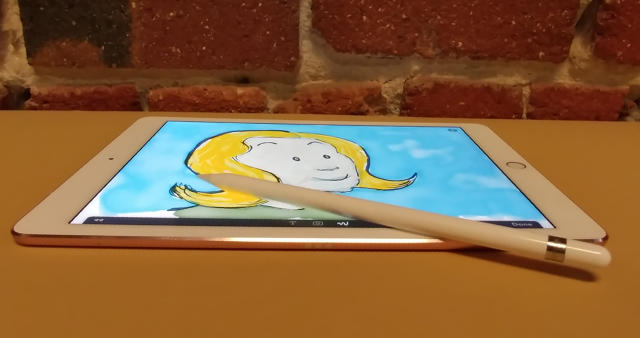
Not that the Pencil is perfect: Unlike Microsoft’s pen for its Surface tablet, which runs for a year on an AAAA battery, it needs to be recharged after a dozen hours or so of use, either with a USB adapter or by plugging it into the iPad’s Lightning port. I also wish that Apple gave some consideration to making it easier to transport the Pencil along with an iPad, in part because its tip tends to pop off if I just shove it in my pocket. But when you’re sitting and sketching—boy, the Pencil is a thrill.
Unlike all third-party keyboards for previous 9.7″ iPads, Apple’s $149 Smart Keyboard—which owes a major debt to Microsoft’s Surface Type Cover—doesn’t require Bluetooth or a battery of its own. You snap it into the iPad Pro’s magnetic Smart Connector, fold the cover to prop up the tablet, and the iPad Pro becomes a mini-laptop. It’s much thinner and lighter than any of the endless supply of existing iPad keyboard cases out there, all of which turn your sleek tablet into a much chunkier package. And when you want to use your tablet like a tablet, you can just fold the Smart Keyboard back.
Design-wise, this Smart Keyboard is a scaled-down version of the one for the larger iPad Pro, with low-profile fabric-covered keys that don’t try to precisely replicate the feel of a laptop keyboard. As a longtime user of iPad keyboards, I long ago trained my fingers to deal with iPad-sized keyboards; after a few months with the 12.9″ iPad Pro, I’ve also forgotten that there’s anything unusual about Apple’s fabric keys. Persnickety touch typists may have more trouble acclimating themselves. Then again, they won’t be thrilled with any other keyboard tailored for a 9.7″ tablet.
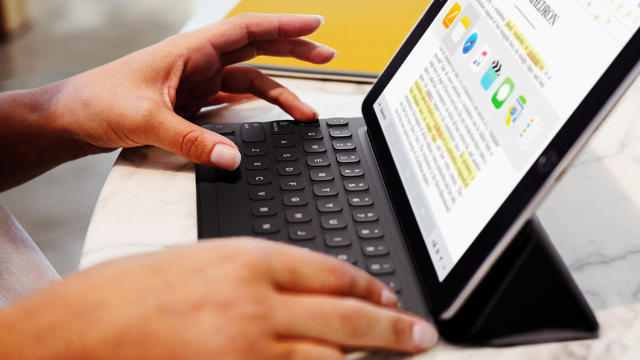
Unlike a bunch of cheaper third-party iPad keyboards, the Smart Keyboard doesn’t have backlit keys, a row of keys for functions such as adjusting volume control, or the ability to position the screen at more than one angle. But my biggest concern involves build quality. On both of the two units I’ve used with the 12.9″ iPad Pro, the A, S, and D keycap legends wore away almost completely within weeks. (In a week and a half of lighter use of the 9.7″ version, I haven’t noticed a similar problem.)
Also on the productivity front, this is only the second 9.7″ iPad, after the iPad Air 2, to fully support iOS 9 multitasking by letting you plunk two apps on-screen at once in Split View mode. If you’re the type who cares about stuff like using an external keyboard, this makes the whole notion of using a tablet as a laptop substitute a whole lot more plausible.
The more professional, less casual positioning of the 9.7″ iPad Pro is also reflected in its pricing, which commands the sort of premium you’ll be more likely to pay if you see the device as a useful tool, and maybe even a primary computing device. Apple had been selling the iPad Air 2 at a starting price of $499; for the new iPad Pro, it bumped that up to $599. Add a Pencil and a Smart Keyboard, and you’ll pay $847. A top-of-the-line rig—256 GB of storage, cellular connectivity, Pencil, Smart Keyboard—will run you $1,277, which is MacBook Pro territory.
Meanwhile, the company knocked the base version of the iPad Air 2 down to $399. That newly thrifty model might be all the iPad you need if you still see the device solely as a handy tool for watching videos, browsing the web, and performing other tasks that are not terribly taxing.
Overall, though, the 9.7″ iPad Pro is exactly the sort of new iPad that Apple needed to offer. Much more than the iPad Air 2, it’s a big enough advance on the models of a few years ago to justify an upgrade for many people—and potent enough that it should keep them happy for years to come.
Review #2: The 9.7″ iPad Pro as a Smaller iPad Pro
The new iPad Pro is nearly the same device as its 12.9″ predecessor—with the Smart Keyboard, Pencil, and general emphasis on ambitious productivity and creativity—but in a more portable size and with a lower starting price. Simple, right?
That’s most of what you need to know if you’re intrigued by the iPad Pro proposition and are considering both versions of the tablet. But not quite.
Just as you’d expect, the new iPad Pro’s size strikes a nice compromise. It’s much roomier than an iPad Mini, but still sized nicely for reading in bed, toting on the subway, and other scenarios where the 12.9″ iPad Pro’s additional bulk make it a bit of a handful. After having used the 12.9″ model for a few months, I’d mostly forgotten that it weighs more than 50% more than a 9.7″ iPad; trying its smaller sibling instantly made me notice the larger model’s extra poundage all over again.
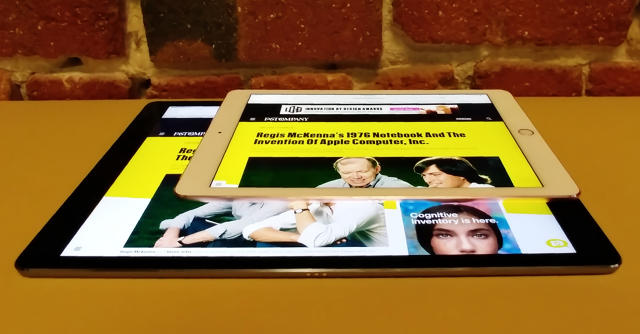
In a way, Apple’s Smart Keyboard makes more sense when sized for the 9.7″ iPad Pro than it did with the larger model. If you opt for the smaller iPad, you presumably care about portability, and the Smart Keyboard is the thinnest, lightest keyboard accessory that anyone’s ever made for an iPad—in part because it doesn’t require its own battery, and in part because it has low-profile, fabric-covered keys rather than more conventional, laptop-esque ones. The price remains stiff, but at $149, it’s 20 bucks less than the 12.9″ variant.
As for the Pencil, it provides the same delightful drawing and note-taking experience on the 9.7″ iPad Pro as it does on the larger one. With a tablet of either size, it’s a key argument in favor of the iPad Pro line.
On the specs front, the 9.7″ iPad Pro is not a carbon copy of the 12.9″ model. Nor has it simply been stripped down to hit a lower price point. Most of the news is good: The screen’s new True Tone technology, improved brightness, and wider color gamut make it meaningfully easier on the eyes than the larger model’s display, and its cameras are much better. Starting now, these display and camera upgrades become obvious items on any wish list for a 12.9″ iPad Pro 2.
Like the 12.9″ iPad Pro, the new one sports Apple’s A9X chip, the most potent processor in any iOS device. It’s a slightly slower version, but it may be a wash given that the 9.7″ iPad Pro’s screen has fewer pixels, and therefore doesn’t require quite as much raw processing power.
Apple gave the new iPad Pro 2GB of RAM, which is half the generous 4 GB allotment of the 12.9″ version. I didn’t detect any performance hit when I performed garden-variety tasks. But if you push a tablet to its limits, 4 GB definitely beats 2 GB. For instance, the 9.7″ iPad Pro ran out of memory and started to reload Safari browser tabs once I’d loaded the FastComany.com home page 15 times. The 12.9″ Pro only did so once I’d loaded the site 36 times, which is the maximum quantity of tabs Safari permits.
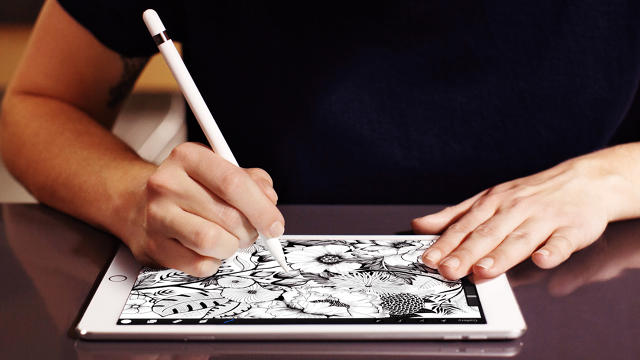
The 9.7″ iPad Pro has more than enough muscle to handle Split View multitasking, one of the most important productivity features Apple has ever added to iOS. And because the screen resolution hasn’t changed from the iPad Air 2, some apps that are still a bit unsightly on the 12.9″ iPad Pro—because they haven’t been rejiggered for the bigger screen—look just fine at 9.7″.
During its launch event, Apple pitched the 9.7″ iPad Pro as a smart replacement for an aging Windows PC. People who really want a new Windows PC should buy one, I say; the iPad is just plain different, and requires significant adjustment of habits and the learning of new software. But its truly touch-optimized interface and profusion of modern apps make for an experience that points the way to the future of computing more clearly than Windows devices, such as Microsoft’s Surface. (I’ve used various iPads as primary computing devices for almost five years myself, and consider it among the happiest moves I’ve ever made as a user of technology products.)
Despite Apple’s positioning of the this model, the 12.9″ incarnation of the iPad Pro is the more logical choice for hardcore productivity of the sort you might otherwise tackle on a Windows PC (or, for that matter, a Mac). Once you’ve planted yourself in one place, its large screen and roomy keyboard both make it easier to accomplish ambitious tasks without squinting or scrolling. For instance, when I stick the Spark email client on the right-hand side of the screen, I can see 12 messages in my inbox on the 12.9″ iPad Pro and only 9 on the 9.7″ version. In full-screen mode, Apple’s own Numbers spreadsheet defaults to 32 rows of 10 columns on the 12.9″ model and 22 rows of 8 columns on the 9.7″ one. Tasks ranging from composing documents in Word to painting in ProCreate benefit from the original iPad Pro’s additional real estate.
Price tag aside, I think many people in a PC-replacing mindset would be happier with the 12.9″ iPad Pro than the 9.7″ version. And the difference in cost isn’t that dramatic: an 9.7″ iPad Pro is only $200 less than the equivalent 12.9″ model, or $220 less if you also spring for a Smart Keyboard. So my advice to anyone who really craves the larger screen but is on a budget is pretty simple: Hold off making a purchase until you’re comfortable buying the big-boy iPad Pro.
That still leaves plenty of folks who would prefer to sacrifice screen space in favor of a size and weight that encourage them to take their tablet anywhere and everywhere. The 9.7″ iPad Pro is that sort of tablet—and the fact that it lives up to its “Pro” moniker in so many ways makes the decision to go small rather than big that much easier.
Related Video: The Evolution of Apple in under 3 Minutes
Fast Company , Read Full Story
(64)

